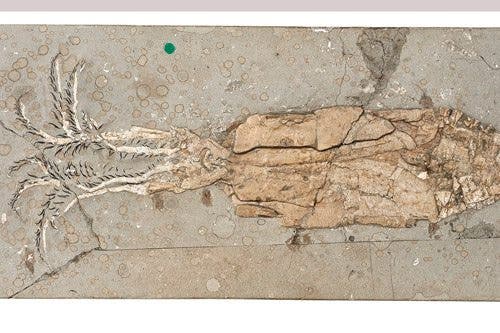
Exceptionally well-preserved fossil of Belemnoteuthis antiquus from 166 million years ago. These ancient cephalopods with their large internal shell were not as fast as their recently evolved relatives. Credit: Jonathan Jackson and Zoë Hughes, NHMUK.
It’s hard to believe it but today’s squishy creatures like octopuses or squids used to have a shell. Unfortunately, being soft-bodied means these animals rarely leave anything behind after they pass which makes tracking their lineage exceptionally difficult. But using a combination of genetic sequencing and fossil remains — few but valuable — researchers at the University of Bristol in the United Kingdom were able to establish when the cephalopods’ last shelled ancestors used to live. According to the results, squids and octopuses lost their shell during the Jurassic and Cretaceous periods.
According to lead researcher Jakov Vinther, a paleobiologist at the University of Bristol, cephalopod ancestors started losing their shells around the Mesozoic Marine Revolution, which was one most important faunal changes in life’s history. Because of pressure from extremely adapted Mesozoic marine predators, many marine invertebrates had to develop new defenses or risk becoming wiped out. This meant ditching the shell which made it difficult to get away in the face of threats.
“On land this was the time of the dinosaurs, but beneath the seas, ecologies were changing rapidly. Fish, squid and their predators were locked in evolutionary ‘arms-races’, leading to increasingly speedy and agile predators and prey,” said Al Tanner, a PhD student at the University of Bristol’s School of Biological Sciences.
What Vinther and colleagues found was a clear demise of the number of squid and octopus ancestors which had heavy internal shells beginning with 160 million years ago. Up until 100 million years ago, some of these cephalopod ancestors gradually lost their hard shells in favor of more squishy body parts familiar today which helped the animals both catch prey and evade predators easier.
“By having a reduced internal skeleton compared to their ancient relatives, the modern squids and octopuses could compress their body and more efficiently jet away leaving a baffling cloud of ink with the attacking predator. Before the predator realises what has happened and gains clear view again, the squid is far out of sight,” Vinther said.
The key to these findings was a genetic technique that enabled the researchers to build a timeline of different cephalopod ancestor branching in the family tree. After the molecular clock results were compared to fossil records, the two converged to paint the story of when squids and octopuses lost their shells.
“The key element of molecular clocks though is the fact that mutations steadily accumulate in genetic material over time – so by figuring out how many mutations per million years you find, and how it may vary between different groups, we can estimate evolutionary time,” said Professor Davide Pisan, co-author of the new paper published in Proceedings of the Royal Society B: Biological Sciences.









